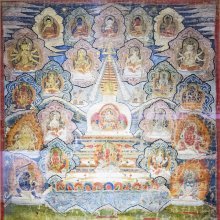Jyotirupa, Jyotirūpa, Jyotis-rupa, Jyotīrūpa: 4 definitions
Introduction:
Jyotirupa means something in Hinduism, Sanskrit, Marathi. If you want to know the exact meaning, history, etymology or English translation of this term then check out the descriptions on this page. Add your comment or reference to a book if you want to contribute to this summary article.
Images (photo gallery)
In Hinduism
Purana and Itihasa (epic history)
Source: archive.org: Shiva Purana - English TranslationJyotirūpa (ज्योतिरूप) refers to he, “whose form is the fire”, and represents an epithet of Śiva used in Sandhyā’s eulogy of Śiva, according to the Śivapurāṇa 2.2.6. Accordingly:—“[...] Directly perceiving the lord of Durgā she [viz., Sandhyā] eulogised the lord of the worlds: [...] Obeisance to Thee whose forms are the sky, the earth, the quarters, the waters, the fire (jyotirūpa) and the Eternal time”.
Jyotirūpa refers to Śiva’s “form of splendour”, according to the Śivapurāṇa 2.2.16:—“[...] On hearing these words of mine—of Brahmā—in the presence of Viṣṇu, Śiva, the lord of worlds spoke to me with his face beaming with a smile: [...] Sometimes I will be thinking about Śiva, my own form of splendour (jyotīrūpa), the eternal principle which the scholars well versed in the Vedas call Imperishable. When I go in trance, O Brahmā, in that meditation, damned be she who causes an impediment therein”.

The Purana (पुराण, purāṇas) refers to Sanskrit literature preserving ancient India’s vast cultural history, including historical legends, religious ceremonies, various arts and sciences. The eighteen mahapuranas total over 400,000 shlokas (metrical couplets) and date to at least several centuries BCE.
Shaktism (Shakta philosophy)
Source: Google Books: ManthanabhairavatantramJyotirūpa (ज्योतिरूप) refers to “one who is light” and is used to describe the Goddess, according to the second recension of the Yogakhaṇḍa of the Manthānabhairavatantra, a vast sprawling work that belongs to a corpus of Tantric texts concerned with the worship of the goddess Kubjikā.—Accordingly, as Śrīkaṇṭha praised the Goddess: “Victory! Victory (to you who are) in the middle of the Liṅga of the Void (khaliṅga), invisible, (you who are) Light [i.e., jyotirūpa] and (whose) form is the Supreme Void (ākāśa), worshipped with great devotion. I have come (to take) refuge (in you) O mistress (svāminī), have mercy on me. [...]”.

Shakta (शाक्त, śākta) or Shaktism (śāktism) represents a tradition of Hinduism where the Goddess (Devi) is revered and worshipped. Shakta literature includes a range of scriptures, including various Agamas and Tantras, although its roots may be traced back to the Vedas.
Yoga (school of philosophy)
Source: ORA: Amanaska (king of all yogas): A Critical Edition and Annotated Translation by Jason BirchJyotīrūpa (ज्योतीरूप) refers to the “appearance of light”, according to sources such as the Candrāvalokana and the Anubhavanivedanastotra.—Accordingly, while describing the highest reality through the practice of Śāmbhavī Mudrā: “[...] [The Yogin’s] eyes are half open, his mind steady and his gaze placed at the tip of the nose. Even his moon and sun have dissolved and his body is motionless. He goes to that supreme intensely radiant state, the highest reality, which has the appearance of light (jyotīrūpa) and is devoid of everything external. What could be spoken of here that is greater [than this]?”.

Yoga is originally considered a branch of Hindu philosophy (astika), but both ancient and modern Yoga combine the physical, mental and spiritual. Yoga teaches various physical techniques also known as āsanas (postures), used for various purposes (eg., meditation, contemplation, relaxation).
Languages of India and abroad
Marathi-English dictionary
Source: DDSA: The Molesworth Marathi and English Dictionaryjyōtirūpa (ज्योतिरूप) [or ज्योतिस्वरूप, jyōtisvarūpa].—n S Light itself. A title of God. " God is Light." i. John i. 5.
Marathi is an Indo-European language having over 70 million native speakers people in (predominantly) Maharashtra India. Marathi, like many other Indo-Aryan languages, evolved from early forms of Prakrit, which itself is a subset of Sanskrit, one of the most ancient languages of the world.
See also (Relevant definitions)
Partial matches: Jyotis, Rupa.
Starts with: Jyotirupasvayambhu.
Ends with: Divyajyotirupa.
Full-text: Jyotirupasvayambhu, Jyotirupeshvara, Hmasinga.
Relevant text
Search found 5 books and stories containing Jyotirupa, Jyōti-rūpa, Jyoti-rupa, Jyoti-rūpa, Jyotī-rūpa, Jyotirūpa, Jyotīrūpa, Jyōtirūpa, Jyotis-rupa, Jyotis-rūpa, Jyōtis-rūpa; (plurals include: Jyotirupas, rūpas, rupas, Jyotirūpas, Jyotīrūpas, Jyōtirūpas). You can also click to the full overview containing English textual excerpts. Below are direct links for the most relevant articles:
Cidgaganacandrika (study) (by S. Mahalakshmi)
Verse 103 [Divyaugha Janani] < [Chapter 3 - Third Vimarśa]
The Agni Purana (by N. Gangadharan)
Prasthanatrayi Swaminarayan Bhashyam (Study) (by Sadhu Gyanananddas)
7.3. The Body of a Mukta in Akṣaradhāma < [Chapter 5 - Analysis on the basis of Soteriology]
Chaitanya Bhagavata (by Bhumipati Dāsa)
Verse 1.16.11 < [Chapter 16 - The Glories of Śrī Haridāsa Ṭhākura]
The Skanda Purana (by G. V. Tagare)
Viṣṇu-sahasranāma (Garland of a Thousand Epithets of Viṣṇu) < [Section 1 - Avantīkṣetra-māhātmya]

